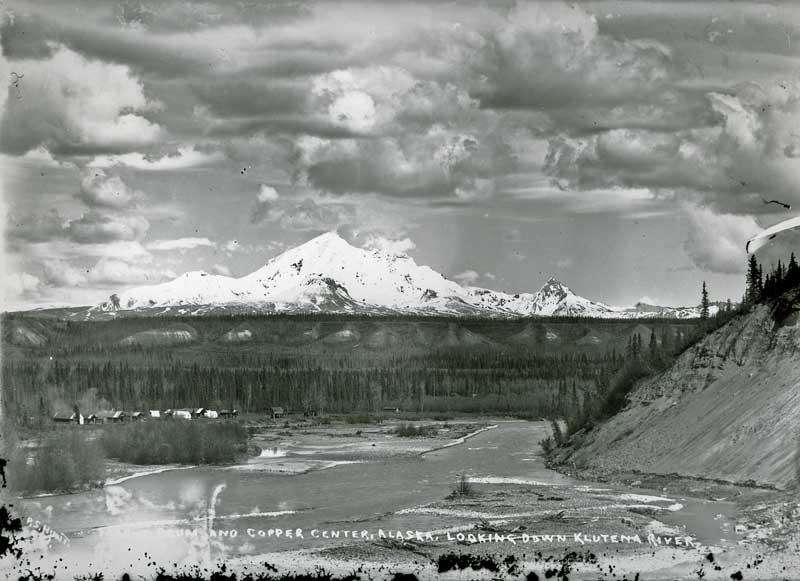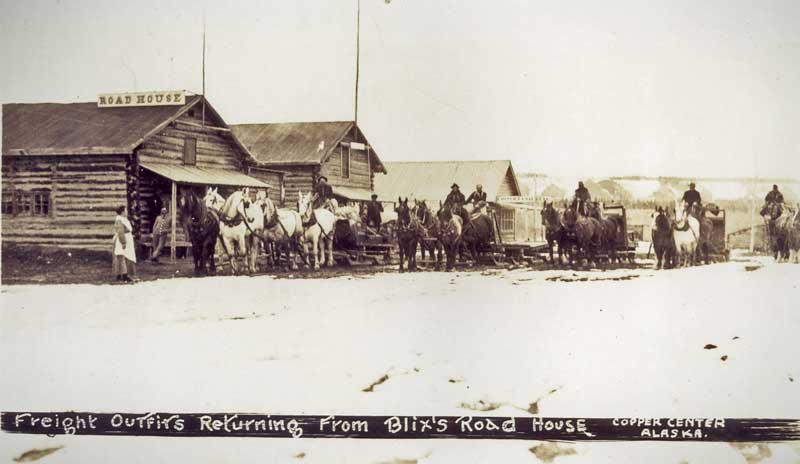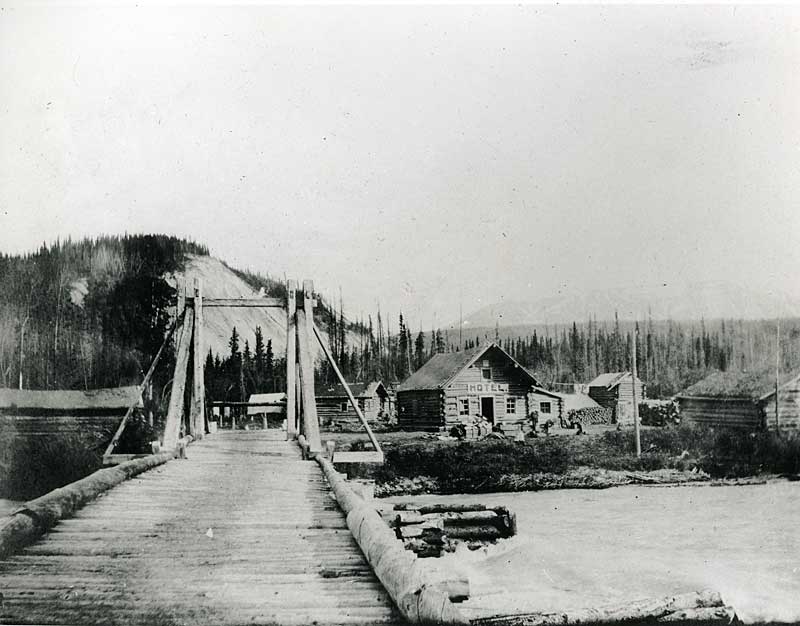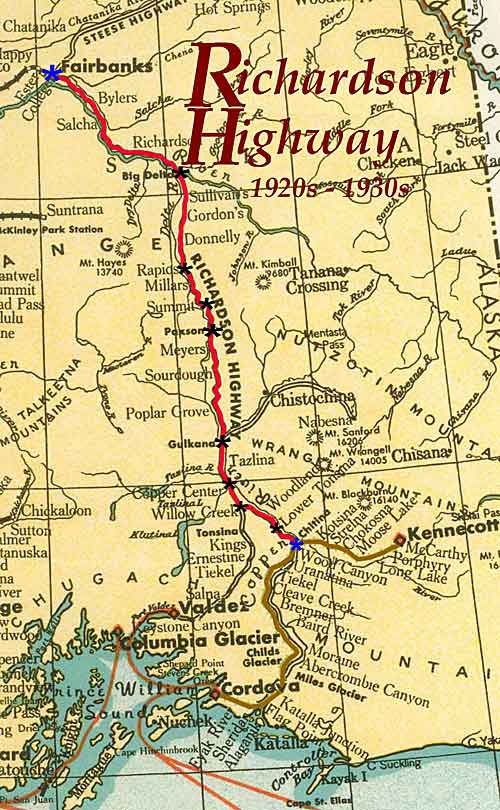Legacy of the Chief,
Chapter 16, Pt 2: "DeHaviland Arrives at Chitina-1923"

Looking down the Klutina River toward the settlement of
Copper Center, Mt Drum in distance. --Anchorage Museum of
History & Art, B62.1A.123
The name Copper Center is a misnomer. No copper mining activity ever
occurred there at all. The place appeared to be something lost in time.
Even the Indian village seemed to be asleep. Like all the others, it
showed signs of extreme poverty and obvious government neglect, even in
comparison to the rudimentary homes of the few white settlers. If there
is any official policy to assist the Indians who live anywhere along the
Richardson route, it is the policy of neglect. It is most striking at
dusty, forgotten Copper Center.
I was told that the name is a result of the area being the center of
activity on the Copper River back during the gold rush in 1898 when
large numbers of would-be miners made their way up the Valdez Glacier
for a very tough climb to an incredibly steep summit, only to follow
another glacier down to a lake on the southern edge of the Copper River
valley. Several tent settlements sprouted up around Klutina Lake, but
the ultimate destination was the Copper River. Those early travelers had
to survive the rushing waters of the Klutina River. It was no journey
for amateurs. Less than ten percent of those who attempted the trek from
Valdez made it to the mouth of the Klutina.
Copper Center became a temporary boom town anyway. Regrettably, no gold
was to be found anywhere near the area. Copper Center became what it
still is. Rather than a destination, it is just another stop along the
way. The place remains to this day a destitute, predominantly Indian
settlement with no apparent purpose.

Blix's Roadhouse at Copper Center
--Candy Waugaman Collection
Even the name Copper River proved misleading. No copper was ever mined
anywhere along the river. It is the Chitina River which leads into the
true copper country. I am told that chiti means copper and na means
river. The southern part of the Nizina and Chitina River valleys became
the ultimate destination for many of those stragglers who survived the
Valdez and Klutina Glaciers. It was the area of another fizzled Alaska
gold rush. It would not be the gold which would place the Copper River
valley on the map, but the copper.
The enormous Bonanza vein outcropping brought in the railroad. For a
while it looked as though the railroad would be continued through Copper
Center when a right-of-way was surveyed following the Richardson route.
Property was even set aside for a railroad yard at Copper Center.
J.P. Morgan, who owned the CRNW Railway at that time, dangled the
railroad in front of the federal government, touting it as the easiest
and cheapest way to have a government-owned railroad accessing the gold
fields around Fairbanks and elsewhere in the interior. He even offered
the line from Cordova to Chitina to the Federal Government for less than
cost. The Wilson Administration had other plans. They bought up the old
Alaska Central Railroad right-of-way out of Seward and developed the
town of Anchorage from the terminal they built at Ship Creek in 1915. As
a result, the CRNW Railway never extended beyond Chitina to Copper
Center and never will. It will always be just a mining railroad, albeit
a very large one.
Copper Center became another historical curiosity which will probably
never amount to much. Even the agricultural experimental station and the
fox farm have long since gone by the wayside. Civilization never really
arrived at Copper Center.
The route from Fairbanks to Copper Center is littered with high hopes
and lost dreams. Many of the lodges are dead or dying. The remaining
ones appear to be over-built. The trail is interesting, but rigorous. It
is not a practical one to follow now that a full-service railway exists
between Seward and Fairbanks. The only activity of any consequence
exists along the railway line which passes through Chitina, which is
isolated by over three hundred miles of almost nothing. It is truly in
the midst of a wilderness.

Junction from Richardson Highway to Chitina by
means of the Edgerton Cut-Off.
The final leg of the trip closely followed the Copper River. Willow
Creek Roadhouse turned out to be nothing but a few cabins. Mrs.
Griffith’s roadhouse at Kenny Lake was being expanded, reflecting an
unfounded optimism based on a level of trade which will never
materialize. In the view of this reporter, few lodging businesses have
any chance of surviving in a wilderness which only the Indians can truly
appreciate. The lodges along the route were built at a time when gold
rush activity justified them. Those days are long over.
The final lodge before reaching Chitina was the Lower Tonsina, a
two-story modern facility that proved to be a truly wonderful lunch
stop.

Nafstead's Lower Tonsina Roadhouse on the Edgerton Cut-Off
road to Chitina
Predictably, the final leg of the trip along the Edgerton Road was much
like the tedious run from Fairbanks to Copper Center. Muddy streams and
stunted forest lands only served to relieve miles of tundra heavy with
mosquitoes. These features are typical of great expanses of the lower
country. They are uninspiring and provide nothing of interest to the
sophisticated traveler.
Chitina is the only town containing first-class accommodations for the
traveler all the way from Fairbanks. The Hotel Chitina, though out of
place in this dusty wilderness, is truly a pleasant surprise and an
especially welcome respite after so many days of traveling through such
primitive country. The entire downtown area is steam-heated and has
electricity and running water. One just wants to stop and rest in a
large, warm bathtub and find badly needed relief from many days of
bone-jerking, mud-crawling, irritating, mosquito-infested travel. This
is just the place to do it. This grand establishment is Oscar Breedman’s
Hotel Chitina. It is the largest hotel in the interior. Sadly, even this
hotel is largely empty. Only about a dozen of its seventy rooms are
occupied. Once the Alaska Railroad reached Fairbanks, the Cordova to
Chitina to Fairbanks run became nothing more than an annoyance.
Down the muddy street, heading west, the Commercial Hotel, which caters
mainly to the miners and other travelers of limited means, is less than
half full. The lot where the three-story Overland Hotel once stood
remains a charred empty spot, unlikely to ever be re-built.
All that remains are the tourist runs. The one out of Valdez follows the
Richardson Trail to Tonsina Lodge--a well-established overnight
destination. The following day the visitors travel to the cut-off for
forty-mile trip to Chitina. The third day involves the highly scenic
ride aboard the Copper River and Northwestern, featuring first class
dining service to Miles and Childs Glacier before the train terminates
at to Cordova , leaving the passengers at the upscale Windsor Hotel
before departure on an Alaska Steamship liner. Tourism is strictly a
summer business. One can only imagine how quiet it must be in this very
remote sub-arctic Alaskan outpost in the winter when no such traffic
exists.

Tourist buses making a brief stop at Summit Lake along the
Richardson Trail
It is plain as the nose on this reporter’s face that this place is
doomed. The vast interior is not dying, it is dead. The people who live
here seem to overlook the obvious. The copper will not last. If one was
to watch the daily procession of ore trains running through Chitina, it
would be easy to believe that it could go on forever. This reporter’s
long experience with boom towns of the American West dictates otherwise.
The end will come sooner than the residents here could ever imagine. The
train will leave one day, never to return. There will be no rich copper
mine, no freight or passenger service, and no tourists. It will simply
end. Most likely, the mine and railroad will die a sudden death, and few
will see it coming or believe what they see when it happens. But it will
vanish. Mark my words and place a flask of the finest brandy and a box
of good Cuban cigars on it. This reporter picks sooner rather than
later. The white settlers who depend on the railroad should count
themselves lucky indeed if they get fifteen more years out of it. The
railroad will quit running and the country will return to the Indians.
Undoubtedly the Indians applaud the end of the copper and the railroad.
Not all that long ago all this was their land. It appears to this
reporter that it will soon be exclusively theirs again. This writer does
not mince words. That’s why he is an independent reporter. Let’s call it
like it is. The Indians probably won’t even miss us. We have done them
no favors here. Time to think about heading home before the welcome mat
wears completely out.

Map showing the locations mentioned in John DeHaviland's itinerary along the Richardson & Edgerton Highways, Fairbanks to Chitina, 1923.
This dispatch goes to the San Francisco Examiner by way of the
government mail pick-up at the Wells-Fargo telegraph office, the CRNW
railroad depot, Chitina, Territory of Alaska.
--John DeHaviland, July 25, 1923
|
No comments:
Post a Comment